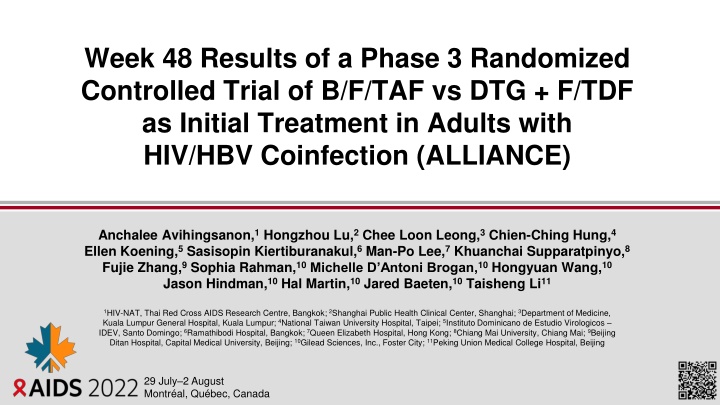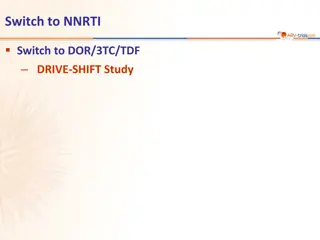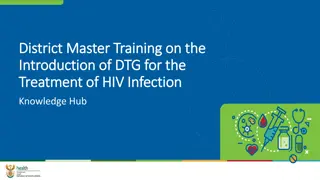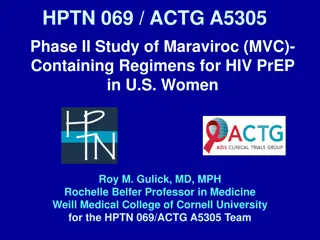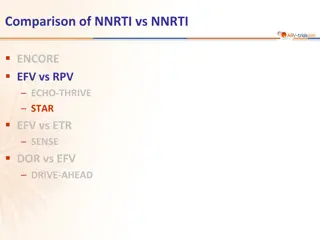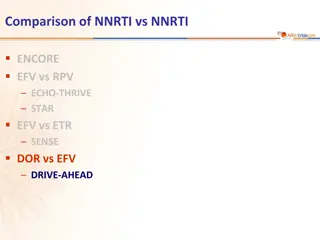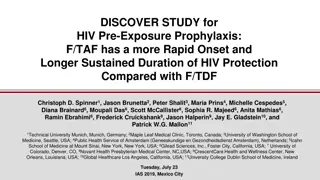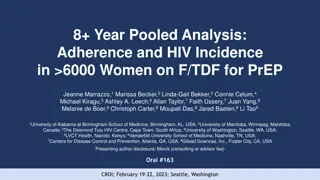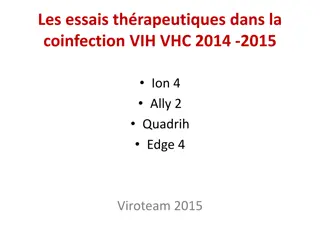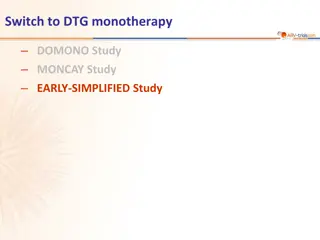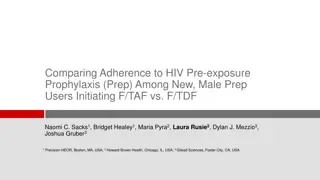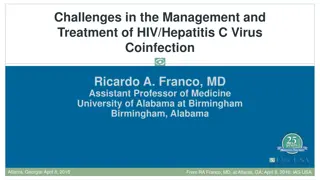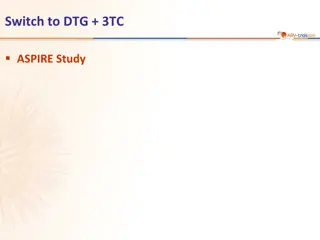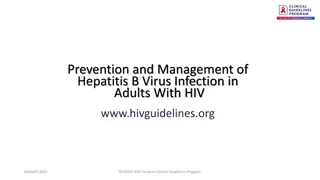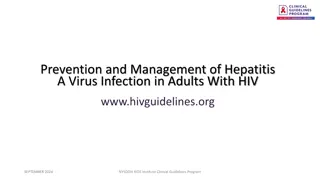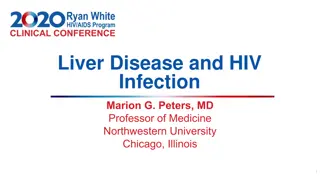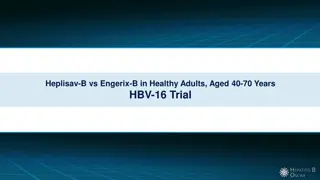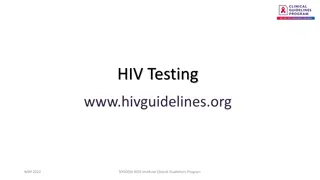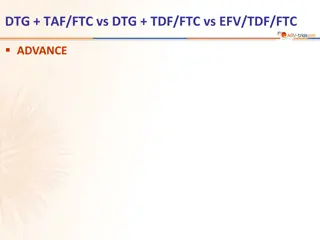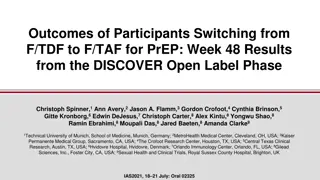Phase 3 Trial of B/F/TAF vs. DTG/F/TDF in HIV/HBV Coinfection
This study compares the efficacy of B/F/TAF vs. DTG/F/TDF as initial treatment in adults with HIV/HBV coinfection. Chronic hepatitis B significantly impacts individuals with HIV, leading to higher morbidity and mortality rates. Guidelines recommend TDF- or TAF-based regimens for HIV/HBV coinfection. The study aims to provide insights into the optimal treatment approach for individuals with both infections.
Download Presentation

Please find below an Image/Link to download the presentation.
The content on the website is provided AS IS for your information and personal use only. It may not be sold, licensed, or shared on other websites without obtaining consent from the author.If you encounter any issues during the download, it is possible that the publisher has removed the file from their server.
You are allowed to download the files provided on this website for personal or commercial use, subject to the condition that they are used lawfully. All files are the property of their respective owners.
The content on the website is provided AS IS for your information and personal use only. It may not be sold, licensed, or shared on other websites without obtaining consent from the author.
E N D
Presentation Transcript
Week 48 Results of a Phase 3 Randomized Controlled Trial of B/F/TAF vs DTG + F/TDF as Initial Treatment in Adults with HIV/HBV Coinfection (ALLIANCE) Anchalee Avihingsanon,1Hongzhou Lu,2Chee Loon Leong,3Chien-Ching Hung,4 Ellen Koening,5Sasisopin Kiertiburanakul,6Man-Po Lee,7Khuanchai Supparatpinyo,8 Fujie Zhang,9Sophia Rahman,10Michelle D Antoni Brogan,10Hongyuan Wang,10 Jason Hindman,10Hal Martin,10Jared Baeten,10Taisheng Li11 1HIV-NAT, Thai Red Cross AIDS Research Centre, Bangkok; 2Shanghai Public Health Clinical Center, Shanghai; 3Department of Medicine, Kuala Lumpur General Hospital, Kuala Lumpur; 4National Taiwan University Hospital, Taipei; 5Instituto Dominicano de Estudio Virologicos IDEV, Santo Domingo; 6Ramathibodi Hospital, Bangkok; 7Queen Elizabeth Hospital, Hong Kong; 8Chiang Mai University, Chiang Mai; 9Beijing Ditan Hospital, Capital Medical University, Beijing; 10Gilead Sciences, Inc., Foster City; 11Peking Union Medical College Hospital, Beijing 29 July 2 August Montr al, Qu bec, Canada
Disclosures I have no relevant financial relationships with ineligible companies to disclose 2
B/F/TAF for People With HIV/HBV Coinfection Chronic hepatitis B (CHB) affects ~8% of people with HIV, and HIV/HBV coinfection rates can reach 25% in areas where both viruses are endemic1-3 Coinfection worsens morbidity and mortality; people with HIV/HBV coinfection have higher HBV DNA levels and have higher risk of cirrhosis and liver cancer than people with HBV monoinfection People with HIV/HBV coinfection should receive treatment to suppress both viruses International guidelines recommend a TDF- or TAF-based ARV regimen in combination with 3TC or FTC as the NRTI backbone for most people with HIV/HBV coinfection4-7 TDF and TAF are approved for the treatment of HBV, and both are widely used as part of an ARV regimen for HIV treatment, but there are no randomized studies of TDF vs TAF- based ART in adults with HIV/HBV coinfection initiating treatment 3TC, lamivudine; B/F/TAF, bictegravir/emtricitabine/tenofovir alafenamide; FTC, emtricitabine; NRTI, nucleos(t)ide reverse transcriptase inhibitor; TDF, tenofovir disoproxil fumarate. 1. Leumi S, et al. Clin Infect Dis. 2020;71:2799-806; 2. Kellerman SE, et al. J Infect Dis, 2003;188:571-7; 3. Kourtis AP, et al. N Engl J Med. 2012;366:1749-52; 4. WHO. Consolidated Guidelines on HIV Prevention, Testing, Treatment, Service Delivery and Monitoring: Recommendations for a Public Health Approach; 2021; 5. EACS Guidelines v11.0, October 2021; 6. DHHS. Guidelines for the Use of Antiretroviral Agents in Adults and Adolescents with HIV; Accessed 30 Jun 2022; 7. Saag MS, et al. JAMA, 2020;324:1651 69. 3
Study Design B/F/TAF QD n=121 Adults with HIV/HBV coinfection, Treatment-Naive to HIV and HBV HIV-1 RNA 500 c/mL HBV DNA 2000 IU/mL Genotypic sensitivity of HIV to FTC, TFV eGFRCG 50 mL/min DTG + FTC/TDF Placebo QD 1:1 DTG + FTC/TDF QD n=122 B/F/TAF Placebo QD Randomization stratified by HBeAg (positive vs negative) HBV DNA (< vs 8 log10 IU/mL) CD4+ cell count (< vs 50 cells/ L) Week 0 96 48 1 Endpoints HIV-1 RNA <50 copies/mL (FDA Snapshot algorithm), 12% noninferiority margin HBV DNA <29 IU/mL (missing = failure analysis), 12% noninferiority margin 4 DTG, dolutegravir; eGFRCG, estimated glomerular filtration rate by Cockcroft-Gault method; HBeAg, hepatitis B e antigen; TFV, tenofovir. ClinicalTrials.gov NCT03547908.
Enrollment and Baseline Characteristics Participants by Geographies (Active Sites), n B/F/TAF n=121 31 (27, 39) 9 (7) DTG + F/TDF n=122 32 (25, 38) 2 (2) 55 Thailand (6) Median age, y (IQR) Female at birth, n (%) Race/ethnicity, n (%) Asian White Black Other Median body mass index, kg/m2 (IQR) Median HIV-1 RNA, log10copies/mL (IQR) HIV-1 RNA >100,000 copies/mL, n (%) Median CD4 cells/ L (IQR) CD4 count <200 cells/ L, n (%) Median HBV DNA, log10IU/mL (IQR) HBV DNA 8 log10IU/mL, n (%) HBeAg positive, n (%) ALT >ULN, n (%)* 39 27 29 China (10) 15 Malaysia (9) 108 (89) 10 (8) 2 (2) 1 (1) 22.2 (19.9, 24.7) 4.7 (4.2, 5.1) 38 (31) 245 (127, 383) 46 (38) 8.0 (6.5, 8.4) 60 (50) 92 (76) 60 (50) 106 (87) 9 (7) 6 (5) 1 (1) 21.7 (19.3, 23.7) 4.7 (4.3, 5.0) 34 (28) 236 (121, 380) 52 (43) 8.1 (6.6, 8.5) 66 (54) 97 (80) 47 (39) 22 5 Taiwan (6) 7 4 Dominican Republic (1) 6 4 5 Turkey (2) 4 3 Spain (4) 2 Japan (3) 5 2 3 Hong Kong (1) 1 United States (3) 3 2 Korea (1) 0 5 *American Association for the Study of Liver Diseases (AASLD) criteria: 25 U/L (females), 35 U/L (males). IQR, interquartile range; ULN, upper limit of normal.
Virologic Outcomes at Week 48: Co-primary Endpoints HIV-1 RNA <50 copies/mL (FDA Snapshot algorithm) 4.1%a (95.001% CI -2.5, 10.8) p=0.21b HBV DNA <29 IU/mL (M=F analysis) 16.6%c B/F/TAF DTG + F/TDF (95.001% CI 5.9, 27.3) p=0.0023d 95.0 100 100 91.0 80 80 63.0 Participants, % 54.1 60 60 43.4 36.1 40 40 20 20 5.7 4.2 3.3 2.5 0.8 0.8 0 0 HIV-1 RNA <50 copies/mL No Virologic Data HBV DNA <29 IU/mL No Virologic Data HIV-1 RNA 50 copies/mL HBV DNA 29 IU/mL 113 119 111 122 5 7 1 4 75 119 53 122 43 119 66 122 1 3 n= 119 122 119 122 119 122 Mean CD4 change from baseline, cells/ L (95% CI): B/F/TAF +200 (175, 226), DTG + F/TDF +175 (152, 198) aBased on Mantel-Haenszel (MH) proportions adjusted by baseline HIV-1 RNA stratum (< vs 100,000 copies/mL); bCochran-Mantel-Haenszel (CMH) test stratified by baseline HIV-1 RNA stratum; cBased on MH proportions adjusted by baseline HBeAg status (positive vs negative) and HBV DNA category (< vs 8 log10 IU/mL); dCMH test stratified by baseline HBeAg status and baseline HBV DNA category. Full analysis set. M=F, missing = failure, CI, confidence interval. 6
Virologic Outcomes at Week 48: Change in HBV DNA B/F/TAF DTG + F/TDF 0 Mean HBV DNA Change, Log10 IU/mL (95% CI) -2 * -4 -6 4 8 0 12 24 Week 36 48 119 122 117 122 118 118 119 120 119 120 117 120 118 119 n= 7 *p<0.05 using analysis of variance (ANOVA) model adjusted by baseline HBeAg stratum and HBV DNA stratum.
HBs/eAg Loss and Seroconversion at Week 48 M=F Serologically Evaluable Full Analysis Set Lossa Seroconversionb 30 30 B/F/TAF DTG + F/TDF Participants, % 20 20 12.6% 15/119 5.8% 7/121 HBsAg * * 8.4% 10/119 3.3% 4/121 10 10 0 0 0 12 24 36 48 0 12 24 36 48 30 30 25.6% 23/90 * ** 23.3% 21/90 ** Participants, % 20 20 14.4% 14/97 HBeAg in participants HBeAg+ at baseline 11.3% 11/97 10 10 0 0 0 12 24 36 48 0 12 24 36 48 Week Week *p<0.05, **p<0.01, CMH tests for HBsAg loss and seroconversion stratified by baseline HBeAg status (positive vs negative) and baseline HBV DNA (< vs 8 log10 IU/mL), tests for HBeAg loss and seroconversion stratified by baseline HBV DNA (< vs 8 log10 IU/mL); aChanges from HBs/eAg+ at baseline to at a postbaseline visit with baseline HBs/eAb /missing; bHBs/eAg loss and HBs/eAb changes from /missing at baseline to + at a postbaseline visit. 8
ALT Normalization Through Week 48 M=F (Full Analysis Set with Baseline ALT > ULN) AASLD Criteriaa 100 B/F/TAF 73.3% 44/60 DTG + F/TDF 55.3% 26/47 80 Participants, % * 60 * 40 20 0 0 12 24 36 48 Week 9 *p<0.05, CMH tests stratified by baseline HBeAg status (positive vs negative) and baseline HBV DNA (< vs 8 log10 IU/mL); aALT ULN 25 U/L (females), 35 U/L (males).
HIV Resistance Through Week 48 B/F/TAF n=119 DTG + F/TDF n=122 Participants, n Met criteria for resistance testinga 3 4 NRTI resistance detected 0 1 INSTI resistance detected 0 0 No treatment-emergent resistance to any components of B/F/TAF occurred in the resistance analysis population One participant on DTG + F/TDF developed NRTI-resistant mutations K70E at Week 24 and M184V/I at Week 36 (no K70E present), was resuppressed by the Week 36 retest, and then was lost to follow up aHIV-1 RNA 200 copies/mL at confirmed virologic failure, Week 48, or last on-treatment visit. (Full Analysis Set). INSTI, integrase strand transfer inhibitor. 10
Adverse Events through Week 48: Overall Summary % Participants B/F/TAF n=121 DTG + F/TDF n=122 Treatment-emergent AE 89 86 Grade 3 or 4 14 16 Treatment-emergent study drug-related AE 24 27 Grade 3 or 4 5 1 Treatment-emergent serious AE 12 12 Treatment-emergent study drug-related serious AE 1a 0 Treatment-emergent AE leading to discontinuation 1b 0 Death 1c 1c 11 aCryptococcal meningitis on Day 32 (resolved on Day 40); bHepatocellular carcinoma on Day 1115 (subsequently died in hospice); cBoth due to unknown cause on Days 28 and 38, respectively.
All Grade and Study Drug-related AEs through Week 48 % Participants B/F/TAF n=121 89 17 13 9 7 11 24 6 1 3 1 2 DTG + F/TDF n=122 86 11 11 12 11 4 27 7 5 2 4 2 Preferred Term Any treatment-emergent AE Upper respiratory tract infection COVID-19 Pyrexia ALT increased Nasopharyngitis All-Grade AEs, Terms 10% Any study drug-related AE Weight increaseda ALT increased Headache Nausea Dizziness Study drug-related AEs, Terms 2% 12 aPreferred terms include weight increased and abnormal weight gain. Median BMI (IQR) change from baseline at Week 48, kg/m2: B/F/TAF +1.3 (0.3, 2.7), DTG + F/TDF +0.8 (-0.5, 1.5).
Grade 3 or 4 Laboratory Abnormalities Through Week 48 % Participants B/F/TAF n=120 34 DTG + F/TDF n=121 31 Maximum Treatment-Emergent Toxicity Grade Any Grade 3 or 4 Grade 3 or 4 occurring in 2% in either group ALT increaseda AST increaseda LDL (fasting, increased) Amylase increasedb Urine glucose increasedc Total cholesterol (fasting, increased) Neutrophils decreased 20 13 8 5 3 3 0 13 12 2 7 2 0 2 13 aWere transient and did not result in discontinuation of therapy; bNo cases of pancreatitis; cNo cases of glycosuria occurred in non-diabetics without concomitant hyperglycemia
Conclusions In adults with HIV-1/HBV coinfection initiating first-line antiviral therapy, after 48 weeks of treatment: B/F/TAF was noninferior to DTG + F/TDF (95% vs 91%) at achieving HIV-1 RNA < 50 c/mL B/F/TAF was superior to DTG + F/TDF (63% vs 43%) at achieving HBV DNA < 29 IU/mL B/F/TAF was associated with higher rates of HBeAg seroconversion compared to DTG + F/TDF (23% vs 11%), with numerically higher but not statistically significant differences between groups in HBsAg loss/seroconversion, HBeAg loss, and ALT normalization No participant developed treatment-emergent HIV-1 drug resistance while on B/F/TAF B/F/TAF and DTG + F/TDF were well tolerated with few study-drug related AEs or discontinuations B/F/TAF is a safe and effective treatment for people with HIV-1/HBV coinfection For 5-year outcomes in adults initiating B/F/TAF, see Sax P, et al. EPB150 14
Acknowledgments Thank you to the ALLIANCE Investigators, Study Staff and All Participants Americas East Asia GE Crofoot E Koenig MN Ramgopal L Santiago S-H Cheng L Dai S He C-C Hung SI Kim M-P Lee L Li T Li H Lu P-L Lu H Nakajima S Oka T Shirasaka H-C Tsai Southeast Asia H Wang M Wang C-C Wang H Wei C-J Yang F Zhang B Zhu Europe / Western Asia JG Garcia MG Hernandez-Mora V Korten M Laguno L Martin-Carbonero O Tabak A Avihingsanon P Chetchotisakd TS Chow HH Chua AM Jelani HB Ker S Khusuwan S Kiertiburanakul CS Kumar HG Lee CL Leong SFBS Omar AKA Rahman W Ratanasuwan K Supparatpinyo This study was funded by Gilead. Editing and production assistance were provided by BioScience Communications, New York, New York, USA, funded by Gilead. 15
